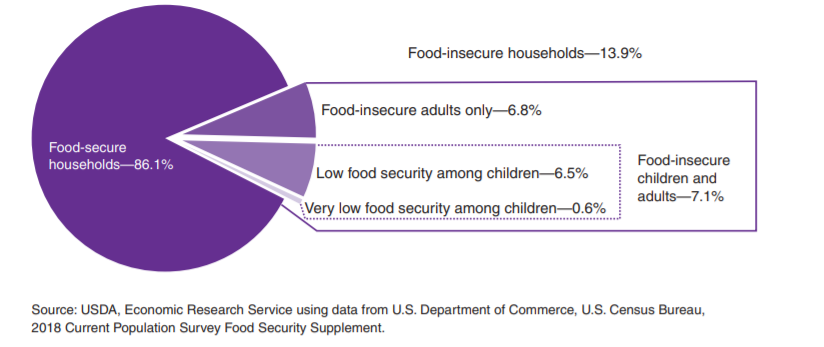Households with children have been hit harder by the financial implications of the COVID-19 pandemic according to the U.S. Census Bureau’s Household Pulse Survey. The recent article “Adults in Households with Children Report Higher Rate of Late Housing Payments and Food Shortages amid COVID-19” suggests that food insufficiency due to the coronavirus pandemic is especially prevalent among adults in households with children. Additionally, they reported that 3.9 million children experienced COVID-19-related food shortages in June.
Food insecurity is defined by Feeding America as a household’s inability to provide enough food for every person to live an active, healthy life. Food insecurity is one way we can measure and assess the risk of hunger in the United States. Food insecurity has wide-ranging health implications especially for children. The article “Food Insecurity and Health Outcomes” published in Health Affairs reviewed the current literature on the health outcomes of food insecurity. Their review found that food-insecurity in children has been associated with an increased risk of birth defects, anemia, lower nutrient intake, cognitive problems, aggression, anxiety, and generally higher odds of being in fair or poor health.
The COVID-19 pandemic has caused the closure of most schools across the nation increasing the vulnerability that children face daily in regards to food security. Many districts around the nation have found ways to continue providing meals to children during this unprecedented time. For example, The Tucson Unified School District provided “Grab & Go” meals to all children 18 years and under during the school closure and over the summer.
Feeding America projects that the number of people experiencing food insecurity is likely to increase due to the pandemic. They project future changes to food insecurity under three scenarios for all individuals and children. Feeding America’s low to high scenario estimates an increase of 1.2 to 6.8 million food-insecure children from the pre-COVID level. To explore the projected impacts the coronavirus may have on food insecurity visit Feeding America.
According to the United States Department of Agriculture article “Household Food Security in the United States in 2018”, 6.0 million children in the U.S. lived in a food-insecure household during 2018. The total share of food-insecure households with children in 2018 was 13.9%, of which 6.8% had food-insecure adults and 7.1% had both food-insecure children and adults. That means that 1 in 7 households with children may not have consistent access to enough food. As the data suggests, parents often provide food for their children even if they have to go without. Figure 1 highlights the food security status of households with children in the U.S. during 2018.
Figure 1: U.S. Households with Children by Food Security Status of Adults and Children (2018)

Several federal nutrition programs exist to provide public support to families in need. These programs include SNAP, National School Lunch Program, School Breakfast Program, and the Summer Food Service Program. The National School Lunch Act allows eligible children to receive a free or reduced lunch. Children eligible for free lunch live in a family with income less than 130% of the federal poverty level, while children eligible for reduced-price lunch live in a family with income less than 185% of the federal poverty level. For reference, the federal poverty level for a family of three is currently $21,720.
In Arizona, over 55% of children were enrolled in the free or reduced lunch program in 2018. According to the Arizona Department of Education Health & Nutrition Services Report for 2018-2019, Arizona had 601,296 students that were eligible for free and reduced meals. That placed Arizona squarely in the middle among the western states. New Mexico posted the highest percentage of children enrolled at 74.1%, while Utah had the lowest at 34.3%. The percent of children who qualified for a free or reduced lunch in the Tucson and Phoenix Metropolitan Statistical Areas (MSAs) were near the state total at 55.5% and 53.1%, respectively. As illustrated in Figure 2, Colorado Springs had the lowest percentage of children enrolled in the free or reduced lunch program at 37.8%, while El Paso had the highest at 73.9%.
Figure 2: Percent of Children Enrolled in the Free or Reduced Lunch Program
In 2018, the percent of children enrolled in the free or reduced lunch program varied widely among the Arizona counties. Greenlee County had the lowest percentage of children enrolled at 42.3% followed by Graham County at 49.7% (see Figure 3). Coconino, Maricopa, Yavapai, and Pima counties were near the state enrollment rate of 55.1%. Apache, Yuma, Santa Cruz, and La Paz counties all had enrollment rates over 70% with La Paz posting the highest. In La Paz County nearly 80% of children receive a free or reduced lunch.
Figure 3: Percent Enrolled in the Free or Reduced Lunch Program (2018)
Nationwide the percent of food-insecure children has declined since 2010. Kids Count provides trend data on the number of children under the age of 18 that were food insecure at some point during the year. For the most part, the U.S. trend holds for many of the western states, including Arizona. However, Arizona’s decline began a little later in 2012 from a high of 30% (see Figure 4). New Mexico is the exception and has posted an increase in the percent of children experiencing food insecurity, however over the past few years the rate has been improving.
Figure 4: Children Living in Households that were Food Insecure at Some Point during the Year
To learn more visit the recent article on the MAP Dashboard that explores the general topic of food insecurity and the impact COVID-19 may have on those individuals.












